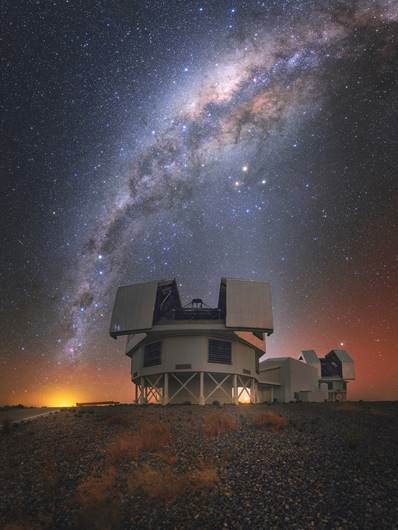Apr 28 2020
Although there are billions of galaxies in the universe, they are not uniformly distributed across space. At present, the universe is highly structured, but this structure and the way it collectively developed and grew continue to be a mystery.
 The Magellan telescopes at Carnegie’s Las Campanas Observatory in Chile, which were crucial to the ability to conduct this survey. Image Credit: Photograph by Yuri Beletsky, courtesy of the Carnegie Institution for Science.
The Magellan telescopes at Carnegie’s Las Campanas Observatory in Chile, which were crucial to the ability to conduct this survey. Image Credit: Photograph by Yuri Beletsky, courtesy of the Carnegie Institution for Science.
A decade-old survey of an unlimited number of galaxies resulted in a novel approach to answer this underlying enigma. This survey was made with the Magellan Baade Telescope installed at the Las Campanas Observatory at Carnegie Institution for Science in Chile.
The results of the study, headed by Daniel Kelson from Carnegie Institution for Science were published in the journal, Monthly Notices of the Royal Astronomical Society.
“How do you describe the indescribable?” asked Kelson. “By taking an entirely new approach to the problem.”
Our tactic provides new—and intuitive—insights into how gravity drove the growth of structure from the universe’s earliest times. This is a direct, observation-based test of one of the pillars of cosmology.
Andrew Benson, Study Co-Author, Carnegie Institution for Science
The Carnegie-Spitzer-IMACS Redshift Survey was specifically made to explore the link between the surrounding environment and the galaxy expansion over the last nine billion years, when the appearances of contemporary galaxies were defined.
The Big Bang initiated the universe as a hot and foggy soup of highly energetic particles, and the initial galaxies emerged after a few hundred million years, following this Big Bang. This material cooled down as it expanded outward from the original explosion, causing the particles to coalesce into neutral hydrogen gas.
A few patches were denser compared to others and, ultimately, the gravity of these patches overcame the outward trajectory of the universe, causing the materials to collapse inward. This led to the formation of the initial clumps of structure in the cosmos.
The difference in density, which led to the formation of both small and large structures in certain places and not in others, has been an old topic of interest. However, until now, the abilities of astronomers to model the growth of the structure in the universe in the last 13 billion years had encountered mathematical limitations.
The gravitational interactions occurring between all the particles in the universe are too complex to explain with simple mathematics.
Andrew Benson, Study Co-Author, Carnegie Institution for Science
Hence, to deal with this problem, the astronomers either utilized mathematical approximations—which contained the precision of their models—or massive computer simulations that numerically model the entire communications that occur between the galaxies. But the astronomers did not consider all the interactions that take place between all the particles, as this was believed to be highly complicated.
“A key goal of our survey was to count up the mass present in stars found in an enormous selection of distant galaxies and then use this information to formulate a new approach to understanding how structure formed in the universe,” explained Kelson.
Now, for the first time, the research group—which also involved Louis Abramson, Shannon Patel, Stephen Shectman, Alan Dressler, Patrick McCarthy, and John S. Mulchaey from Carnegie Institution for Science, and also Rik Williams currently from Uber Technologies—revealed that the development of individual proto-structures can be computed and subsequently averaged across all the space.
This method demonstrated that thicker clumps grew more rapidly, while less-dense clumps grew more gradually. Then, the researchers successfully worked backward and established the initial distributions and growth rates of the density differences. These differences in density would ultimately become the massive structures that established the distributions of galaxies that are observed today.
Essentially, the researchers’ study gave an easy but precise description of how and why the fluctuations in density developed the way they do in the actual universe, and also in the computational-based study that underpins one’s interpretation of the beginning of the universe.
“And it’s just so simple, with a real elegance to it,” Kelson added.
Such findings would not have been achieved without the allocation of a unique number of viewing nights at Las Campanas.
Many institutions wouldn’t have had the capacity to take on a project of this scope on their own. But thanks to our Magellan Telescopes, we were able to execute this survey and create this novel approach to answering a classic question.
John Mulchaey, Director, Las Campanas Observatory, Carnegie Institution for Science
“While there’s no doubt that this project required the resources of an institution like Carnegie, our work also could not have happened without the tremendous number of additional infrared images that we were able to obtain at Kitt Peak and Cerro Tololo, which are both part of the NSF’s National Optical-Infrared Astronomy Research Laboratory,” Kelson concluded.